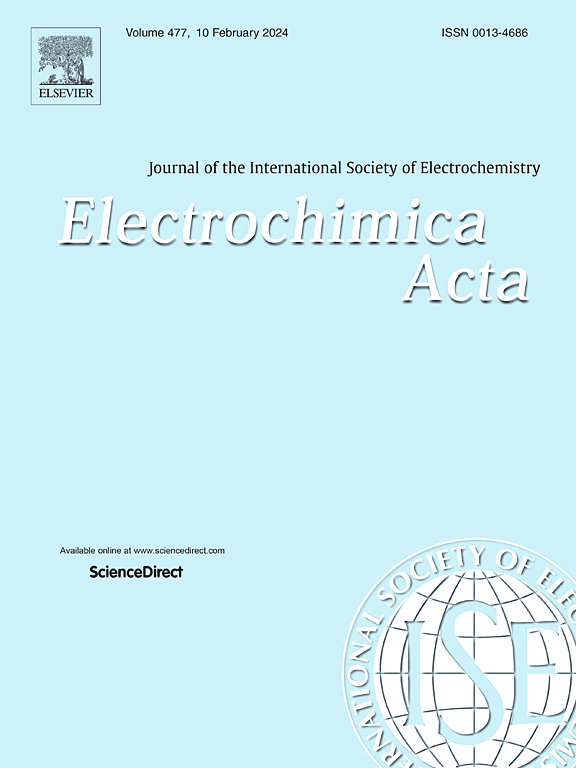用于多菌灵分析的微型传感器水凝胶电化学电池
IF 5.6
3区 材料科学
Q1 ELECTROCHEMISTRY
引用次数: 0
摘要
水凝胶(HG)由于具有高保水率、可调孔隙率和优异的离子导电性等特性,在电化学领域已成为一种很有前途的材料。它们作为固态电解质和支持氧化还原反应的能力使其成为生物传感器和环境监测等电分析应用的理想选择。本文主要研究了汞作为电化学电池的合成、表征及其在多种基质中检测多菌灵(CBZ)的应用。为了实现这一目标,使用3D笔和由PLA和石墨组成的导电丝(3D/PLA- gr /ME)制造了微型传感器,为电分析应用提供了一个具有成本效益和可重复性的平台。HG结构由聚丙烯酰胺组成,以丙烯酰胺为单体,双丙烯酰胺为交联剂,过硫酸铵为聚合引发剂,在温和条件下一步合成。采用傅里叶变换红外吸收光谱(FTIR)、拉曼光谱(Raman)、循环伏安法(CV)、扫描电镜(SEM)和能量色散x射线光谱(EDS)对其进行了表征。利用扫描电镜(SEM)、CV和电化学阻抗谱(EIS)对3D/PLA-Gr/ME微型传感器进行了表征,以评估其结构和电化学性能。在电极插入之前,HG在目标溶液中浸泡至少8小时,以便开始分析。利用EIS和CV对CBZ在HG中的电化学行为进行了研究。优化后的方波伏安法(SWV)在2 ~ 15µmol L⁻¹的线性范围内,具有良好的分析性能(LD = 0.46µmol L⁻¹),准确度高,对食品和饮料样品的回收率在95% ~ 105%之间。本文章由计算机程序翻译,如有差异,请以英文原文为准。


Hydrogel-based electrochemical cells for carbendazim analysis using a miniaturized sensor
Hydrogels (HG) have emerged as promising materials in electrochemistry due to properties like high water retention, tunable porosity, and excellent ionic conductivity. Their ability to function as solid-state electrolytes and support redox reactions makes them ideal for electroanalytical applications such as biosensors and environmental monitoring. This study focused on synthesizing, characterizing, and applying HG as electrochemical cells for detecting Carbendazim (CBZ) in various matrices. To achieve this, mini-sensors were fabricated using 3D pens and conductive filaments composed of PLA and graphite (3D/PLA-Gr/ME), providing a cost-effective and reproducible platform for electroanalytical applications. The HG structure consisted of polyacrylamide, synthesized in a single step under mild conditions using acrylamide as the monomer, bis-acrylamide as the cross-linking agent, and ammonium persulfate as the polymerization initiator. It was characterized using Fourier Transform Infrared Absorption Spectroscopy (FTIR), Raman Spectroscopy, Cyclic Voltammetry (CV), Scanning Electron Microscopy (SEM), and Energy-Dispersive X-ray Spectroscopy (EDS). The 3D/PLA-Gr/ME mini-sensor was characterized using SEM, CV, and Electrochemical Impedance Spectroscopy (EIS) to assess its structural and electrochemical properties. The HG was immersed in the target solution for a minimum of 8 h before electrode insertion, enabling the initiation of analysis. The electrochemical behavior of CBZ within the HG was examined using EIS and CV. The optimized Square Wave Voltammetry (SWV) method exhibited a linear working range of 2 to 15 µmol L⁻¹, delivering excellent analytical performance (LD = 0.46 µmol L⁻¹) and high accuracy, with recovery rates between 95 % to 105 % in food and beverage samples.
求助全文
通过发布文献求助,成功后即可免费获取论文全文。
去求助
来源期刊

Electrochimica Acta
工程技术-电化学
CiteScore
11.30
自引率
6.10%
发文量
1634
审稿时长
41 days
期刊介绍:
Electrochimica Acta is an international journal. It is intended for the publication of both original work and reviews in the field of electrochemistry. Electrochemistry should be interpreted to mean any of the research fields covered by the Divisions of the International Society of Electrochemistry listed below, as well as emerging scientific domains covered by ISE New Topics Committee.
 求助内容:
求助内容: 应助结果提醒方式:
应助结果提醒方式:


